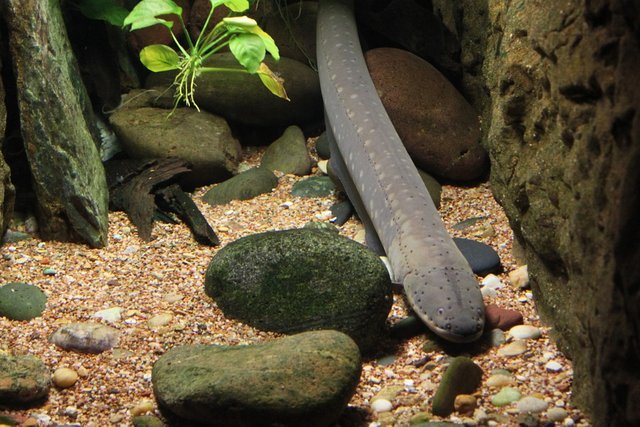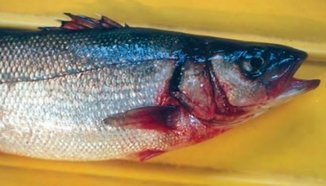Microbial World #9 Vibrio anguillarum (a fish pathogen)
A potential threat to the larviculture and aquaculture
Hello Steemians,
Today, in the series of microbial world I have a bacterial species known to infect the marine and fresh water fishes. As in one of my previous article of microbial world on Luminescence bacteria, I have shared the bacterial species responsible for the luminescence (Vibrio sp.) and there are some other species of this genus present in fresh and marine water responsible for infecting the fishes.

Vibrio anguillarum a gram negative, curved-rod bacteria having one polar flagellum also known as Listonella anguillarum. An important pathogen of cultured salmonid causing vibriosis or red pest of eels (a haemorrhagic septicaemic disease). If you are familiar with the salmon life cycle and their importance to the ecosystem, you must also be aware of how much disastrous it could be if all the salmon’s die due to such infections.
While in aquaculture these infections are leading to huge economical loss worldwide. As the organism is leading a high morbidity and mortality rates, worthwhile research has to be carried out to understand the virulence mechanism and easy and fast detection and effective diseases curing strategies. So, I will be covering all the necessary points like mechanism , detection and prevention and treatment.

It was first seen in as the "red pest of eels" in the migrating eels (Anguillla anguilla) and was referred to be caused by a bacterium species Bacterium anguillarum a few years later Bergman named it Vibrio anguillarum the causative agent for "red pest of eels". The bacterium grows rapidly in the medium containing 1.5-2% sodium chloride (NaCl) producing round and creamy colored colonies (1).
Vibriosis (Susceptible organism)

Clinical signs of disease
The fatal haemorrhagic septicaemia also known as salt-water furunculosis, boil disease and ulcer disease. Most common sign of vibriosis includes weight loss, lethargy, red spot on both sides of body and swallon and dark skin lesion that bleed and can ulcerate. Pathogen found in high concentration in the blood and tissues, also reported to infect the eyes resulting in the blur vision. The organism infect almost all parts gastrointestinal tract, rectum etc. In acute epizootics, infection spreads very rapidly which results in the death of many fishes without any clinical signs (4).
Infection route
Infection route of this bacterial species is still a topic of discussion, they are known to infect through skin as well as by oral intake of pathogen (5). In most of the cases it was found that the major infection was caused through penetration of skin. While, oral ingestion of V. anguillarum also results in the development of infection usually carried in water through the contaminated food or waste spillage. Although the bacterium growth is inhibited at low pH, but they are able to survive in the stomach acidic environment. While the pH of larvae is not that low so, in any outbreak bacterium is more likely to found in the larvae stomach (6). From there they further moves to blood stream and results in blood poisoning (septicaemia) further infecting rest of the internal organs. Motility and chemotaxis also plays a crucial role in the infection.
Fish Immune system

To overcome these enemy threat fishes developed a non-specific defense mechanism using iron-binding protein such as transferrin, ferrin and others and making iron unavailable for the microorganism (Siderophore-dependent iron-acquisition system). However by producing such mechanism of iron uptake provide the fish some protection from the several bacterial species, but V. anguillarum can breech this defense mechanism because they have evolved in a way that they have a self replicating system pJM1 (plasmid), containing the desired genes to overcome such issues (9).
Diagnosis and Detection

Prevention and Treatment
Antibiotics have been used for the treatment of bacterial infection for many years, to minimize the use of antibiotics and to have more effective treatment for the larviculture and aquaculture some inactivated bacterial vaccine and DNA vaccines, use of some non-specific immunostimulant. However, more research is required in this area to investigate and develop a better way to treat this, there is always a better option to try with.
Conclusion
Vibrio anguillarum an economically important pathogen in aquaculture and larviculture. It's still a major challenge to avoid every outbreak of vibrosis, the complete pathogenesis mechanism is still not clear and study is being going on to improve the situation.
References
Bacteria from fish and other aquatic animals
Bacteria from fish: a practical identification manual.
Ellis et. al., 1999 Immunity to bacteria in fish 9(4);291-308.
Holland et. al., 2002 The complement system in teleosts 12(5);399-420.
Previous articles on Microbial World

Microbial World #6 Bioluminescent Bacteria
Microbial World #7 Halocin: Bacteriocin from halobacteria
Microbial World #8 Bacteria Synthesizes Nano-Sized Compasses to Navigate Earth's Geometric Field
Hope you have found this article inrteresting. If you do please upvote, resteem and comment.
Happy Reading :)

Sneaky Ninja Attack! You have been defended with a 6.38% vote... I was summoned by @vinamra! I have done their bidding and now I will vanish...Whoosh